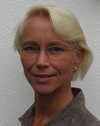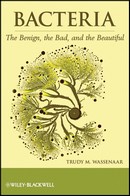Dr. Trudy Wassenaar presents her new book about the life of bacteria
Published: November 7, 2011
By: Engormix.com
Dr. Trudy Wassenaar, founder and principal research consultant of Molecular Microbiology and Genomics Consultants (MMGC), talks about her new book, "Bacteria: the Benign, the Bad and the Beautiful", a book published by John Wiley & Sons Inc. which is now on sale.
 Dr. Wassenaar has a BSc in Biochemistry from the University of Swansea, Wales, UK. She undertook her PhD in veterinary Science at the University of Utrecht. In 1998, Trudy started her own consultancy company "Molecualr Microbiology and Genomics Consultants". Through MMGC, she consults research groups on molecular microbiology and genomics of microorganisms, and assists in research design, planning, problem solving, data analysis, project management and in preparation of proposals and manuscripts. Trudy also teaches courses in applied bioinformatics for microbiologists. Currently, she is also a part-time associate professor at DTU, Center for Biological Sequences.
Dr. Wassenaar has a BSc in Biochemistry from the University of Swansea, Wales, UK. She undertook her PhD in veterinary Science at the University of Utrecht. In 1998, Trudy started her own consultancy company "Molecualr Microbiology and Genomics Consultants". Through MMGC, she consults research groups on molecular microbiology and genomics of microorganisms, and assists in research design, planning, problem solving, data analysis, project management and in preparation of proposals and manuscripts. Trudy also teaches courses in applied bioinformatics for microbiologists. Currently, she is also a part-time associate professor at DTU, Center for Biological Sequences.
 Dr. Wassenaar has a BSc in Biochemistry from the University of Swansea, Wales, UK. She undertook her PhD in veterinary Science at the University of Utrecht. In 1998, Trudy started her own consultancy company "Molecualr Microbiology and Genomics Consultants". Through MMGC, she consults research groups on molecular microbiology and genomics of microorganisms, and assists in research design, planning, problem solving, data analysis, project management and in preparation of proposals and manuscripts. Trudy also teaches courses in applied bioinformatics for microbiologists. Currently, she is also a part-time associate professor at DTU, Center for Biological Sequences.
Dr. Wassenaar has a BSc in Biochemistry from the University of Swansea, Wales, UK. She undertook her PhD in veterinary Science at the University of Utrecht. In 1998, Trudy started her own consultancy company "Molecualr Microbiology and Genomics Consultants". Through MMGC, she consults research groups on molecular microbiology and genomics of microorganisms, and assists in research design, planning, problem solving, data analysis, project management and in preparation of proposals and manuscripts. Trudy also teaches courses in applied bioinformatics for microbiologists. Currently, she is also a part-time associate professor at DTU, Center for Biological Sequences.1- What´s your book about and why have you chosen this title?
The book describes the life of bacteria - and explains that there are many different kinds of bacteria, with very different life styles. Thus there are bad bacteria, that make (some of us) ill, good bacteria that help us maintain good health, and beautiful bacteria, that are just fascinating to learn about. That was the origin of the title, but in fact the book describes more than just benign, bad or beautiful organisms. When I started doing research for this book I already knew that bacteria are both plentiful and diverse, but that their lives could be so different and interesting I had not expected. There are so many stories to tell about bacteria that it wasn't easy to make a selection.
2- What segment of the population did you have in mind when you conceived the idea for this book?
My first intention was to introduce bacteria to a general audience, as many people only have a vague idea that bacteria exist. Some people associate bacteria with what I call the three D's: the D of dirt, disease and death. I tried to counter that, describing how the vast majority of bacteria live their little lives without paying much attention to us. But when I started exploring the bacterial world at depth I realized the book is also of interest to people with a little more knowledge of the subject, or even to highly educated microbiologists. The reason is that all microbiologists are trained and taught only a minor part of the bacterial world. For example, a food microbiologist will learn everything about bacteria that spoil fresh foods, and about the bacteria that are needed to produce fermented foods, but they learn little about the bacteria that help vegetables grow vegetables in the first place, or those bacteria that digest the feed of animals in their guts, thus being essential for the production of our diary products or our meat. Likewise, medical doctors learn a lot about disease-causing bacteria, but are virtually oblivious of marine microbial life, or those organisms living in the deep soil. The book tries to make up for this bias. I suggest learning a bit about everything, before specializing. Therefore I think the book could be a nice introduction to microbiology or bacteriology for students, before they specialize in whatever they will study. And it makes easy reading as such!
3- Will readers be able to use this information in the field?
I do hope so. For instance, a general public will be able to judge the value of hygiene and at the same time will appreciate that not all bacteria need to be killed. In fact, the book gives examples of the many bacteria living on our skin, in our mouth, in our guts and so on, and it is emphasized that these bacteria are completely normal, and often beneficial. There is no need for the majority of antibacterial products that are on the market. Students can use the literature listed at the end of the book if they want to learn more about a specific subject. Lecturers can even use the book in their courses, for instant by asking students to write a paper on a particular subject, or to convert an existing chapter into a textbook chapter. It is a good exercise to start with a simple text and then add complexity based on literature research. And although the texts are kept simple, the facts mentioned in the book are scientifically correct, at least according to present knowledge.
4- How can people get a copy of the book?
The book will be published at the end of November 2011, but it is for sale from the publisher's website already, and will soon be available from Amazon. Once it is out, one can buy it at book stores, and if it isn't on the shelves yet, the store can order it. I hope the book will be both interesting and fun for many readers.

Learn more about the author:
Source
Engormix.comRelated topics:
Authors:
Molecular Microbiology and Genomics Consultants
Recommend
Comment
Share
Molecular Microbiology and Genomics Consultants
18 de noviembre de 2011
The book can be ordered from the Wiley website:
http://www.wiley.com/WileyCDA/WileyTitle/productCd-1118107667.html
The price is:
USD 39.95
EUR 32.40
GBP 26.95
From January onwards it can also be delivered through Amazon.com, where you can already post your order.
Recommend
Reply
Exotic Biosolutions
18 de noviembre de 2011
Book seems to be very interesting.I am sure it will add much to the knowledge.It will be useful for students,professionals and academician. I would love to have this book in my collection.
Thanks Dr.Trudy!!
Recommend
Reply
Recommend
Reply
Engormix
17 de noviembre de 2011
Dear Mubasher Bajwa,
Unfortunately, Dr. Wassenaar´s book will be only for sale and you can find more details in the last question of the interview where I asked where people can get a copy of this book.
Thanks,
Recommend
Reply
Recommend
Reply

Would you like to discuss another topic? Create a new post to engage with experts in the community.














